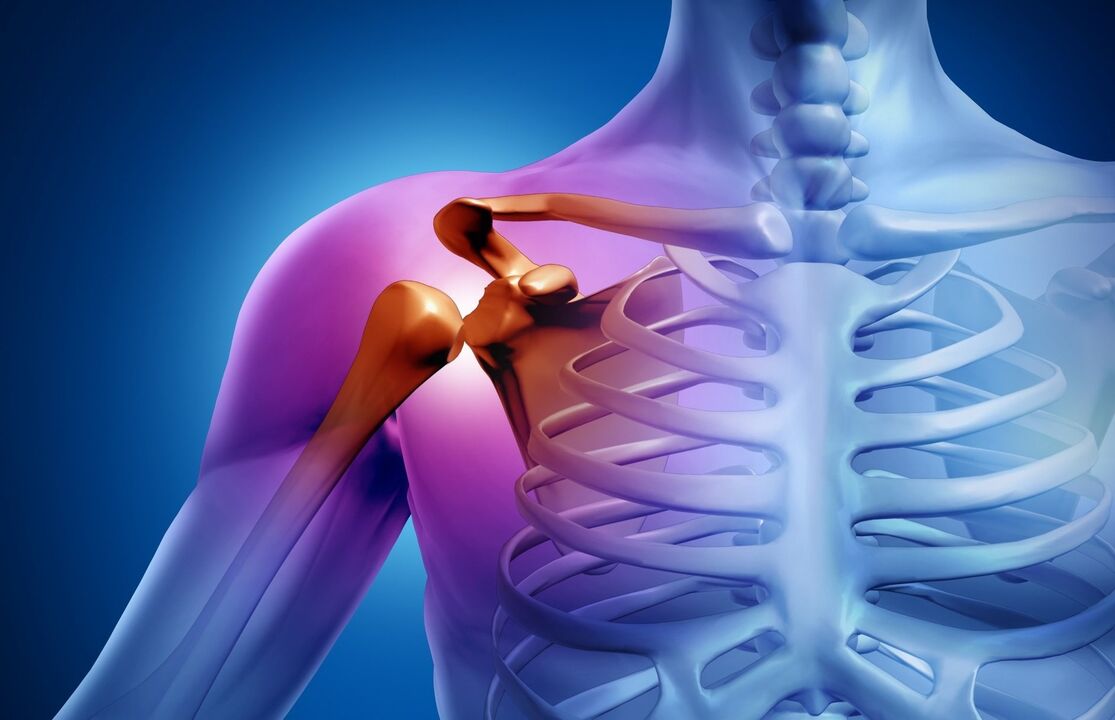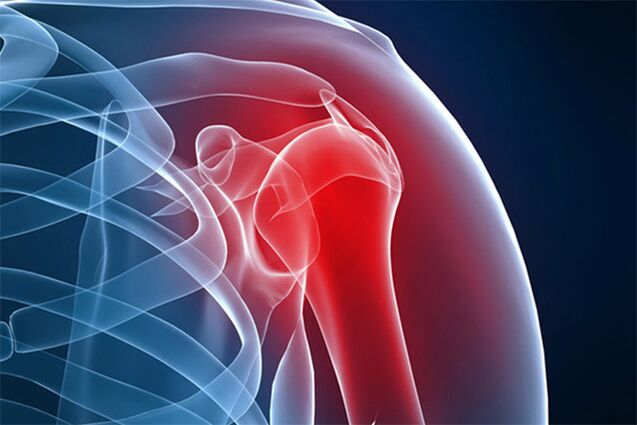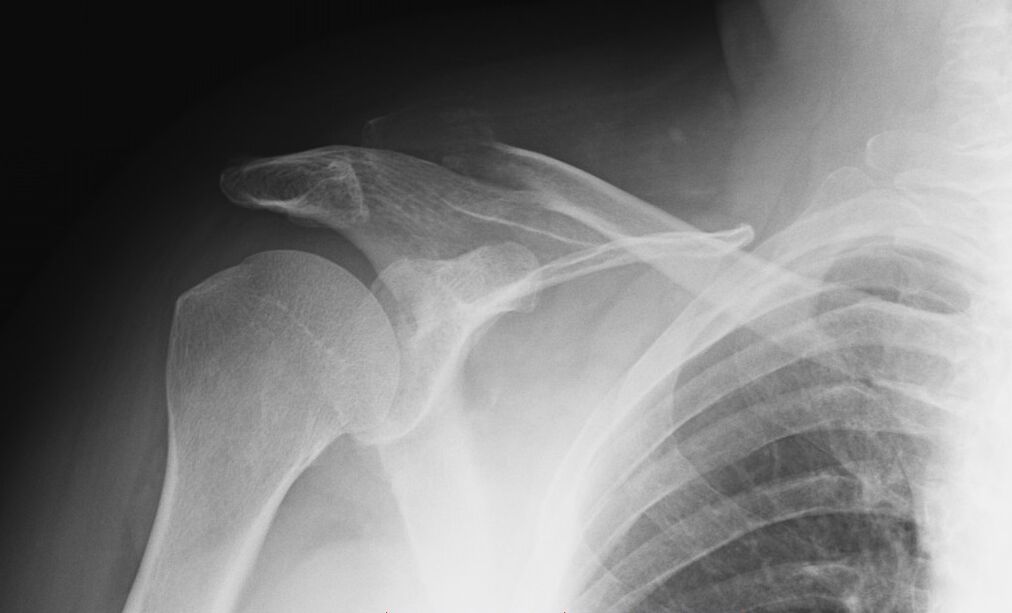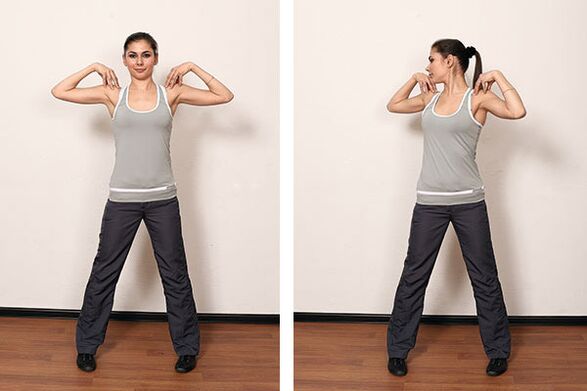Shoulder arthrosis is a widespread chronic disease associated with damage to articular structures. The pathological process is accompanied by degenerative deformation of the articulatory surface. In this case, not only cartilage tissue is damaged, but also bone tissue. Pathological symptoms and methods of treatment depend on the degree of damage to the joint.
The disease can develop over several years without showing itself. At some point, under the influence of adverse factors (hypothermia, trauma, severe concomitant illness), the first signs of the disease appear. At this time it is necessary to consult a doctor, because combating dystrophic changes in cartilage is very effective at the beginning of the disease.

Causes of shoulder arthrosis
The causes of degenerative-dystrophic damage to joint tissue are many and varied. Among them, injury plays a major role, so arthrosis after trauma of the shoulder joint is considered the most common form of pathology. It can be provoked even with slight, but repeated damage to the cartilaginous tissue.
In addition, the disease can occur under the influence of the following pathological factors:
- Severe joint damage: synovitis, gout, acute or chronic arthritis, aseptic necrosis of the humerus.
- Frequent joint overuse. Often observed in athletes involved in volleyball, tennis, basketball.
- Congenital pathology of the shoulder joint.
- Endocrine diseases.
- Old age and senility.
- Overweight (obesity).
- Avitaminosis.
- Autoimmune lesions and immune system weakness.
- genetic predisposition.
Most of those who are sick are people who engage in tedious physical work. Therefore, arthrosis of the right shoulder joint is diagnosed more frequently than the left.

The disease usually develops under the influence of not one, but several adverse factors at once. Based on this, treatment should be comprehensive and aimed not only at combating the disease, but also at eliminating all the causes that cause it.
Characteristic signs of the disease
Shoulder arthrosis, which invisibly begins and develops gradually, can suddenly appear after serious injury, hypothermia or physical exercise. In this case, there are characteristic symptoms of damage to the shoulder joint and nearby tissues:
- pain;
- crackling and clicking during hand movements;
- stiffness and reduced range of motion in the shoulder.
The disease most often occurs in a chronic form. The severity of the disease can be triggered by excessive pressure on the joints or injury.
The intensity of symptom manifestations largely depends on the severity of damage to cartilage and bone tissue, so it is customary to distinguish between several stages of the disease. Such systematization significantly simplifies the diagnosis and allows you to accurately predict the outcome of the disease.
Shoulder arthrosis I degree
During this period, the joint tissue is slightly affected. Pain is observed very rarely and only after doing excessive physical exercise or prolonged tedious work. Patients most often do not pay attention to these symptoms, associating them with overwork or muscle tension. Defeat of 1 degree is only treated with conservative methods.
At the onset of the disease, there were no obvious changes in cartilage tissue on x-ray, only oval rings were noted around the articular cavity.
Degree of shoulder arthrosis II
At this stage, the symptoms of the disease become more pronounced. Cartilage tissue becomes thinner and deformed, intra-articular ligaments are damaged. During hand movements, a buzzing sound is heard, the lining in the articular bag becomes inflamed. Over time, the pain became persistent. Morning stiffness and limited movement appear, which can lead to muscle atrophy.

Degree III shoulder arthrosis
During this period, the joint is already significantly deformed, there is almost no movement in it. Patients experience acute pain that can spread to the arms and shoulder blades. If you do not stop further tissue destruction, pathological processes can lead to disability.
Third -degree disease is not suitable for conservative treatment and requires surgical intervention.
Arthrosis of the shoulders rarely reaches the third phase. Often, the second stage is diagnosed with a transition to the chronic form.
Which doctor to contact
Often, people dealing with joint pain do not know who to turn to. At the first symptoms of the disease, you need to visit a rheumatologist. The specialist will not only conduct a complete physical examination and make a diagnosis, but also, if necessary, relieve severe pain with the help of intra-articular injections of anesthetics.
With advanced forms of the disease, rheumatologists may be powerless. In this case, you need a surgeon or orthopedic specialist. In big cities, you can make an appointment with an arthrologist who only deals with joint disease.
How to deal with shoulder arthritis
After medical examination and diagnosis, the doctor prescribes specific therapies that allow you to achieve a long and stable remission of the disease. It is not possible to cure degenerative changes in the joints, but slowing down the course of the destructive process and alleviating the patient’s condition is a fully feasible task.
The main goal of antiarthrosis therapy is to relieve pain and restore joint mobility.
Modern drug therapy
In some patients, it is difficult to make an accurate diagnosis in the early stages of the disease. At this stage, the pain is not expressed and does not force the patient to seek help from a specialist. Often they are treated independently with folk remedies. Some patients perform therapeutic exercises to reduce pain and stiffness in the joints. For the treatment of arthrosis, medications prescribed by a doctor are used, adhering to the recommended dosage and duration of administration. The most effective are the following groups of drugs:
- non-steroidal anti-inflammatory drugs;
- chondroprotector;
- corticosteroid medications;
- non -narcotic analgesics;
- vasodilator;
- muscle relaxants.
Many medications for this pathology are sometimes prescribed for a long time. Depending on the severity of the disease, medications are taken orally, applied externally, injected intramuscularly or into the cavity of the shoulder joint.
Nonsteroidal anti-inflammatory drugs (NSAIDs)
NSAIDs are contraindicated for use for a long time due to the presence of side effects from the gastrointestinal tract.
It is possible to treat the disease with drugs that are already in the early stages of development of pathological processes. The course is determined based on the patient's condition and the severity of symptoms. As an independent treatment, ointments belonging to this group are not prescribed. They are used in combination with a similar group of drugs used intramuscularly or orally. Their job is to reduce inflammation and alleviate the patient’s condition.
Chondroprotectors
Almost all patients are included in drug treatment regimens aimed at improving metabolic processes in cartilage tissue. In addition, they increase the elasticity of cartilage. Chondroprotectors have such properties. These medicinal ingredients differ depending on the main active ingredient based on the ingredients of its manufacture:
- hyaluronic acid;
- chondroitin sulfate;
- glucosamine;
- joint funds.
Glucosamine is a substance that plays an important role in the formation of healthy cartilage tissue. The job of chondroitin sulfate is to nourish and provide cushion on the shoulders.
Preparations for monotherapy have more proven themselves in the market than a combination of ingredients.
The polysaccharide contained in the intercellular space is hyaluronic acid. It is also able to reduce the sensitivity of receptors that respond to pain. Combined chondroprotectors, which contain several active ingredients, have the biggest advantages.
The use of chondroprotectors is most effective in the early stages of the disease. The job of the drug is the synthesis of new cells of healthy cartilage tissue, which replace the damaged tissue. With the presence of pain and swelling, drugs from this group will be less effective. Therefore, it is first necessary to use anti-inflammatory drugs to alleviate the patient's condition.
To obtain maximum effect, injectable preparations are used for intra-articular or intramuscular administration. The course of treatment with chondroprotectors takes up to six months, some patients see the first results after 3 months of therapy. It is important to follow some rules in the treatment of such drugs.
With the beginning of the course of therapy, physical load, stressful situations should be excluded. The patient will receive the greatest impact if he or she starts taking chondroprotectors, improves nutrition, and engages in physiotherapy exercises. Many patients with arthrosis of the shoulder joint are involved in the method of Dr. Bubnovsky, they perform a set of exercises specially designed to achieve a gradual recovery of the joint or stop the progression of the disease.
Corticosteroid agents
When severe pain appears, if anti-inflammatory drugs do not bring a positive effect, corticosteroids are prescribed. To alleviate the patient’s condition, an ointment or injection is prescribed.
Analgesic
In the early stages of the disease, analgesics are prescribed to reduce pain.
Compared with non-steroidal anti-inflammatory drugs, drugs from this group have less negative effects on the mucosa of the gastrointestinal tract.
Having an unspoken anti-inflammatory effect, they are effective against pain.
Vasodilator
Mandatory means in the treatment of arthrosis are vasodilators. They relieve vascular spasms, normalize blood flow in the affected area. Many patients complain of the appearance of night pain, which is effectively addressed by drugs from this group.
Relax your muscles
When osteoarthritis of the shoulder joint is affected, muscle spasm is considered a common occurrence, which is relieved by muscle relaxation. When prescribing it, the principle of complexity is observed, it is used in conjunction with painkillers and anti-inflammatory drugs. If necessary, the minimum dose is initially set with a gradual increase.
Surgical treatment
The main objective of the operation is to restore the working capacity of the joints and improve the quality of life of the patient. If conservative therapy is ineffective, persistent pain syndrome persists, the joint gradually changes shape, and the range of movement in it is very limited, the patient is indicated for surgical intervention.
Decisions about the need for surgery are made by the orthopedic specialist or traumatologist along with the patient. Then the dimensions of the endoprosthesis and the material from which it will be made are determined. Today, implants are made of high -strength titanium and polymers, almost as heavy as natural joints. The durability and reliability of endoprosthesis is beyond doubt.
Recovery period
Surgery to replace an affected joint most often goes without complications. Fixation with a support bandage is required for the first 14 days. Initial passive performance of physical training complexes on special devices and devices is allowed. Power load is allowed after 45-60 days.
Physiotherapy
Any anti-arthritis training complex is only useful during remission. If there is an increase in temperature, pain and other symptoms that exacerbate the disease, charging is contraindicated.
Exercise therapy should not cause pain or discomfort. The slightest discomfort, exercise should be abandoned.

Charging needs to be done daily. After the load, it is useful to do a self -massage on the affected joint area and nearby muscles, using a healing cream, which the attending physician will help you choose.
Physiotherapy
Physiotherapy allows you to increase the effects of medications, reduce their dose and minimize the risk of complications. The type of physiotherapy is determined by the doctor, guided by the patient's condition, the neglect of the process and possible contraindications due to the corresponding disease.
Often, the following physiotherapy procedures are used in treatment:
- magnetotherapy;
- ultrasound with hydrocortisone;
- electrophoresis with anti-inflammatory and analgesic substances;
- ultraviolet irradiation
- treatment with laser and infrared radiation.
Physiotherapy is conducted in a course of 10-15 sessions several times a year.
Treatment with folk methods
Combining folk remedies with drug therapy, exercise therapy, proper nutrition and physiotherapy, you can achieve a long and stable remission.
One of the best recipes is a compress using birch leaves, which has anti-inflammatory and warming effects. Young leaves are most suitable, because the closer to autumn their beneficial properties decrease. Before making a compress, a small massage of the affected limb is necessary. Then the leaves are applied to the skin, reinforced with cling film and bandages. Compressed left overnight. The treatment period is 10 days.
Salt baths have a healing effect. Before the procedure, the crystals are pre-dissolved in hot water. Then the resulting solution is poured into the bath. This procedure requires about 3 kg of salt. Alternatively, you can add a few drops of any essential oil. It is best to take a bath before bed, the duration of the bath should not exceed 30 minutes.
Hot oatmeal compresses help a lot. They should be poured with boiling water, insist and used for their intended purpose. Such a procedure is recommended to be performed at night.
No less useful herbal poultice. Crushed plants with anti-inflammatory action (yarrow, ginger, turmeric, cinquefoil, calamus) are mixed with boiling water, kept for 10 minutes under cover and rubbed on the sore spot. After the procedure, the affected shoulder should be rubbed with a healing and sleeping cream.
In it it is recommended to take an infusion of corn stigma. One teaspoon of raw material or 1 bag of filter is mixed with 200 ml of boiling water, insist under the lid for 30 minutes and eaten 1 tbsp. spoon half an hour before meals.
Prevention of osteoarthritis of the shoulder joint
Disease prevention can be primary and secondary. Key prevention includes the following activities:
- regular exercise - jogging or brisk walking, exercises for the shoulder girdle muscles;
- cold and hot showers;
- elimination of excessive load and avoidance of traumatic situations.
- timely treatment of diseases that can trigger shoulder arthrosis;
Secondary prevention is aimed at early diagnosis and treatment of arthritis.
Conclusion
Restoration of joint function is a long and difficult process. Treatment of shoulder arthrosis should be aimed primarily at eliminating the symptoms of the disease. Only complex therapy, combining medical and folk methods, will bring relief and restore working capacity.













































